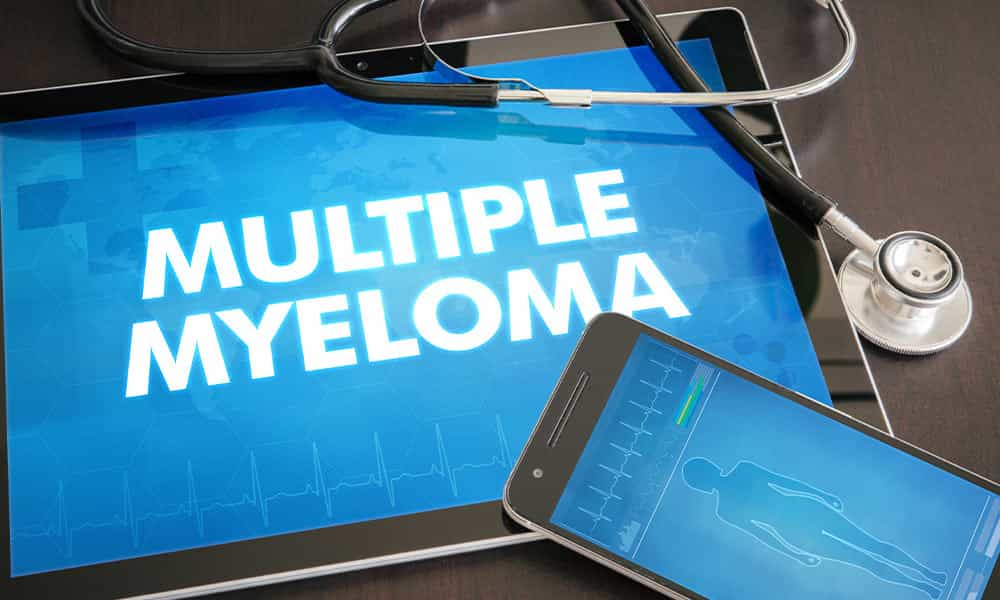Multiple myeloma is a cancer that originates from a type of white blood cells called plasma cells. These cells are primarily found in the bone marrow and are an important part of the immune system, as they produce various antibodies used by our bodies to fight infections.
Multiple myeloma damages the plasma cells, which turn into cancerous cells known as myeloma cells that, instead of producing the useful antibodies, produce an excessive amount of a single antibody called paraprotein or protein M. However, this antibody is not useful to the human body. Over time, myeloma cells multiply and accumulate in the bone marrow, where they grow and mature into progenitor cells for red blood cells, white blood cells, and platelets (the cells that circulate in the bloodstream. This causes problems in various organs, primarily the kidneys.
Who gets multiple myeloma?
Multiple myeloma is the second most common blood cancer.
Globally, more than 750,000 people are living with this disease.
It is usually diagnosed as people age, peaking over age 65. The likelihood of developing myeloma is greater in male individuals. A diagnosis of monoclonal gammopathy of undetermined significance (MGUS) is a risk factor for developing multiple myeloma.
It is unclear what causes myeloma; however, as with other neoplasms, the risk is increased in people exposed to radiation for accidental or therapeutic reasons (radiation therapy) and in relatives of myeloma patients, indicating the possible contribution of acquired and congenital genetic alterations in the onset of the disease.
How is multiple myeloma diagnosed?
Multiple myeloma is a complex form of cancer. Several tests are usually needed to make an accurate diagnosis. Your doctor will decide which tests are necessary. The most common ones are listed below.
The diagnosis is made by identification of typical pathologic cells (tumor plasma cells) in the bone marrow following bone marrow aspirate and/or bone marrow biopsy. The disease is accompanied, in a high percentage of patients, by the presence in the blood of the antibody produced by the diseased cells (monoclonal component), which can be identified with a specific blood test, the serum protein electrophoresis or protidogram.
Other laboratory signs frequently present at diagnosis are altered renal function, anemia, increased antibody levels, and increased calcium.
Radiological investigations may show signs of bone erosion (osteolytic areas) or its complications (fractures).
The good news is that tremendous progress has been made in recent years in the diagnosis and treatment of multiple myeloma. Over the past two decades, intense scientific research has led to the development of several new types of drugs. 10 years ago there were only 3 innovative active ingredients, but today there are more than twice as many.
You may also like
Symptoms of multiple sclerosis in women
Multiple sclerosis (MS) is an autoimmune disease that affects the central nervous system, causing a variety of symptoms in women of all ages. MS is a chronic disease that progressively evolves and can have negative consequences on the quality of life of affected women. One of the main symptoms of MS in women is fatigue.… Continue reading Symptoms of multiple sclerosis in women
Symptoms of multiple sclerosis in men
Multiple sclerosis (MS) is a chronic disease of the central nervous system that affects millions of people worldwide, including a significant number of men. MS is an autoimmune disease that affects myelin, a substance that surrounds and protects nerve cells in the brain and spinal cord. This impairs the brain’s ability to communicate with the… Continue reading Symptoms of multiple sclerosis in men
What is atopic dermatitis and which treatments are most suitable
Atopic dermatitis, also known as endogenous eczema, is a benign disease with a multifactorial aetiology, which, together with asthma and allergic rhinitis, is one of the atopic diseases, i.e. diseases related to the tendency of certain (atopic) individuals to manifest amplified immune responses to small amounts of allergens. We distinguish two forms of atopic dermatitis… Continue reading What is atopic dermatitis and which treatments are most suitable
Atopic dermatitis: what it is and its symptoms
The aetiopathogenesis of atopic dermatitis The exact aetiopathogenesis of atopic dermatitis is not known, but certainly involves genetic and environmental factors. Atopic dermatitis is often associated with elevated serum levels of total IgE, the immunoglobulins that are formed following an allergic and immunological reaction, and the presence of specific IgE directed towards aeroallergens or food… Continue reading Atopic dermatitis: what it is and its symptoms
